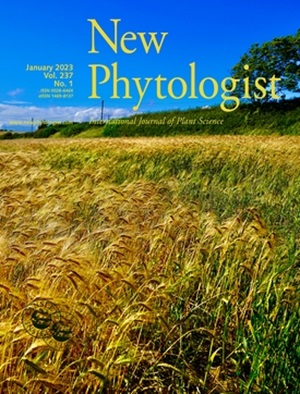Apoplastic pH is a chemical switch for extracellular H2O2 signaling in abscisic acid-mediated inhibition of cotyledon greening
IF 8.3
1区 生物学
Q1 PLANT SCIENCES
引用次数: 0
Abstract
- The apoplastic pH (pHApo) in plants is susceptible to environmental stimuli. However, the biological implications of pHApo variation have remained largely unknown.
- The universal stress phytohormone abscisic acid (ABA) as well as the major environmental stimuli drought and salinity were selected as representative cases to investigate how changes in pHApo relate to plant behaviors in Arabidopsis. Variations in pHApo negatively regulated the cotyledon greening inhibition to the universal stress hormone ABA or environmental stimuli through the action of extracellular hydrogen peroxide (eH2O2).
- Further studies revealed that an increase in pHApo diminishes the chemical reactivity of eH2O2, effectively functioning as an ‘off’ switch for its action in oxidizing thiols of plasma membrane proteins. Consequently, this suppresses the eH2O2-mediated cotyledon greening inhibition to environmental stimuli and ABA, alongside inhibiting the eH2O2-mediated intracellular Ca2+ signaling. Conversely, a decrease in pHApo serves as an ‘on’ switch for the action of eH2O2.
- In summary, the pHApo is a crucial messenger and chemical switch for eH2O2 in signal transduction, notwithstanding the apparent simplicity of the underlying mechanism. Our findings provide a novel fundamental biological insight into the significance of pH.
在脱落酸介导的子叶绿化抑制中,胞外pH是细胞外H2O2信号的化学开关
植物的外胞体pH值(pHApo)易受环境刺激的影响。然而,pHApo变异的生物学意义在很大程度上仍然未知。以拟南芥为研究对象,以普遍胁迫植物激素ABA (abscisic acid, ABA)和主要环境刺激干旱和盐度为代表,探讨了pHApo基因的变化与植物行为的关系。pHApo的变异通过细胞外过氧化氢(eH2O2)的作用负向调节子叶对通用应激激素ABA或环境刺激的绿化抑制。进一步的研究表明,pHApo的增加降低了eH2O2的化学反应活性,有效地关闭了其氧化质膜蛋白硫醇的作用。因此,这抑制了eh2o2介导的子叶对环境刺激和ABA的绿化抑制,同时抑制了eh2o2介导的细胞内Ca2+信号传导。相反,pHApo的减少充当了eH2O2作用的“开启”开关。综上所述,尽管潜在机制明显简单,但pHApo是信号转导中eH2O2的关键信使和化学开关。我们的发现为pH值的意义提供了一种新的基本生物学见解。
本文章由计算机程序翻译,如有差异,请以英文原文为准。
求助全文
约1分钟内获得全文
求助全文
来源期刊

New Phytologist
生物-植物科学
自引率
5.30%
发文量
728
期刊介绍:
New Phytologist is an international electronic journal published 24 times a year. It is owned by the New Phytologist Foundation, a non-profit-making charitable organization dedicated to promoting plant science. The journal publishes excellent, novel, rigorous, and timely research and scholarship in plant science and its applications. The articles cover topics in five sections: Physiology & Development, Environment, Interaction, Evolution, and Transformative Plant Biotechnology. These sections encompass intracellular processes, global environmental change, and encourage cross-disciplinary approaches. The journal recognizes the use of techniques from molecular and cell biology, functional genomics, modeling, and system-based approaches in plant science. Abstracting and Indexing Information for New Phytologist includes Academic Search, AgBiotech News & Information, Agroforestry Abstracts, Biochemistry & Biophysics Citation Index, Botanical Pesticides, CAB Abstracts®, Environment Index, Global Health, and Plant Breeding Abstracts, and others.
 求助内容:
求助内容: 应助结果提醒方式:
应助结果提醒方式:


